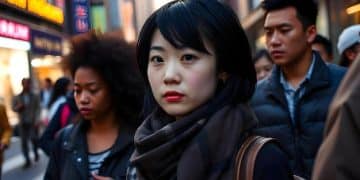Beyond the Subtitles: Unveiling Symbolism in J-Dramas

Unveiling hidden symbolism in J-Dramas enriches the viewing experience, providing deeper insights into cultural nuances, character motivations, and thematic undercurrents often missed through mere dialogue and plot.
Delving into the world of Japanese dramas, or J-Dramas, offers more than just engaging storylines and captivating characters. Beyond the Subtitles: Unveiling the Hidden Symbolism in these shows can significantly enhance your understanding and appreciation of the narratives presented.
The Art of Subtext in J-Dramas
Japanese dramas often employ subtext to convey complex emotions and cultural nuances that are not explicitly stated in the dialogue. Understanding this subtext is key to fully appreciating the storytelling. This section explores how unspoken cues and visual elements contribute to the overall narrative richness of J-Dramas.
Non-Verbal Communication
A significant part of Japanese culture emphasizes non-verbal communication. Facial expressions, body language, and even the way characters hold themselves can reveal a great deal about their feelings and intentions. For example, a slight bow can indicate respect, while avoiding eye contact might signify discomfort or deference.
Implied Meaning
Many crucial plot points or character developments are conveyed through implication rather than direct exposition. This requires viewers to pay close attention to the context and interpret the underlying meanings of scenes and interactions. Recognizing this reliance on implied meaning allows viewers to become more actively engaged in deciphering the story.
- Subtle gestures often replace lengthy monologues.
- Environmental cues can foreshadow events or reflect a character’s emotional state.
- Cultural norms influence the way characters interact, adding layers of meaning.
Recognizing and interpreting these subtle cues can significantly enhance your viewing experience, providing a deeper connection to the characters and their stories. Paying attention to what is *not* said is often just as important as understanding the spoken dialogue.

Symbolism Through Visual Elements
J-Dramas are visually rich, and many elements are carefully chosen to add symbolic depth to the story. From colors to objects, each visual component can represent a specific theme, emotion, or cultural concept. This section explores how these visual elements contribute to the overall narrative.
Color Psychology
Colors in J-Dramas are often used to evoke specific emotions or represent certain character traits. Red might symbolize passion or danger, while blue could signify tranquility or sadness. Understanding the cultural significance of colors can provide valuable insights into the meaning behind certain scenes.
Objects and Props
Every object placed within a scene can hold symbolic weight. A broken object might represent a shattered relationship, while a specific type of flower could symbolize a particular emotion or memory. Paying attention to the details of the set design can reveal hidden layers of meaning within the narrative.
- Red: Represents passion, danger, or vitality.
- White: Symbolizes purity, innocence, or mourning.
- Black: Connotes death, mystery, or formality.
By carefully analyzing these visual cues, viewers can gain a richer understanding of the messages being conveyed beyond the dialogue. The deliberate use of color and objects enhances the storytelling and adds depth to the characters and their journeys.
The Significance of Cultural Motifs
Cultural motifs play a crucial role in J-Dramas, reflecting Japanese traditions, beliefs, and values. These motifs can range from traditional clothing to religious symbols, adding layers of meaning to the narrative. This section explores how these motifs contribute to the authentic portrayal of Japanese culture within J-Dramas.
Traditional Clothing
The type of clothing a character wears can indicate their social status, personality, or emotional state. For instance, a kimono worn in a specific style might represent a particular cultural tradition or ceremony. Recognizing these details can provide insight into the character’s background and identity.
Religious Symbols
Shinto and Buddhist symbols frequently appear in J-Dramas, often representing spiritual beliefs or moral dilemmas faced by the characters. These symbols can add depth and complexity to the narrative, reflecting the values and beliefs of Japanese society.
- Kimono: Symbolizes tradition, formality, and social status.
- Torii Gate: Represents the boundary between the human and spiritual worlds.
- Omamori: Serves as a talisman to protect against misfortune or ensure good luck.
An awareness of cultural motifs enhances the viewing experience, leading to a deeper appreciation of the nuances and complexities woven within the storyline. These motifs are essential for understanding the cultural context of the dramas.

Decoding Common Tropes in J-Dramas
J-Dramas often employ certain tropes that viewers should be familiar with to better understand the story and character dynamics. These tropes can be romantic, comedic, or dramatic, and they serve to create familiar yet engaging narratives. This section explores common tropes and how understanding them can enrich the viewing experience.
The Tsundere Character
The tsundere character, who initially appears cold or hostile but gradually reveals a warmer, more caring side, is a common trope. Understanding this archetype helps viewers recognize the character’s underlying emotions and motivations, even when they are not explicitly expressed.
Love Triangles
Love triangles are a frequent plot device used to create tension and emotional drama. These triangles often involve complex relationships and conflicting desires, providing ample opportunity for character development and dramatic twists.
- Tsundere: A character who is initially cold but warms up over time.
- Childhood Friend: A character who has known the protagonist since childhood and often harbors unrequited feelings.
- The “Perfect” Suitor: A character who seems ideal but may have hidden flaws or conflicting desires.
By familiarizing themselves with these common tropes, viewers can more easily predict plot developments and understand character motivations, resulting in a more enjoyable and insightful viewing experience.
Analyzing Dialogue for Hidden Clues
Even in translation, dialogue in J-Dramas can be rich with hidden clues and double meanings. The way characters speak to one another, the words they choose, and the tone they use can all reveal important information about their relationships and the unfolding plot. This section explores how to analyze dialogue to uncover these hidden clues.
Honorifics and Politeness Levels
Japanese language uses honorifics and different levels of politeness to indicate social hierarchy and respect. Paying attention to these linguistic nuances can provide insight into the power dynamics between characters and their relationships with one another.
Figurative Language
J-Dramas often employ figurative language, such as metaphors and similes, to convey complex emotions or ideas. Interpreting these figures of speech can add depth to the understanding of the dialogue and reveal hidden layers of meaning.
- Keigo: (polite language): Reflects respect, reveals the speakers social standing.
- Indirect Speech: Implies more than what’s literally expressed, hinting at true feelings.
- Proverbs: Expresses cultural wisdom and insights, enriching the dialog.
By carefully analyzing the dialogue, viewers can uncover hidden clues and gain a deeper appreciation of the subtle nuances of the storytelling. Paying attention to the linguistic and cultural cues within the conversations can unlock a wealth of information.
How Music and Sound Enhance Symbolism
Music and sound effects in J-Dramas are not merely background elements; they are integral components that enhance the overall symbolism and emotional impact of the story. The careful use of sound can foreshadow events, amplify emotions, and underscore thematic elements. This section explores how music and sound contribute to the narrative depth of J-Dramas.
Thematic Music
Certain musical themes are often associated with specific characters or plot lines. These themes can evoke particular emotions or foreshadow upcoming events, adding depth and nuance to the storytelling. Paying attention to these recurring musical motifs can enhance the viewer’s understanding of the narrative.
Sound Effects
Sound effects, such as ambient noise or specific sound cues, can be used to create atmosphere or symbolize certain ideas. For example, the sound of rain might represent sadness or cleansing, while the chirping of crickets could symbolize tranquility or loneliness.
- Melody and Rhythm: Evoke feelings and foreshadow dramatic turns.
- Silence: It builds tension and emphasizes crucial moments.
- Ambient Sound: It creates atmosphere and sets tone for emotional impact.
By recognizing the symbolic use of music and sound, viewers can enhance their emotional engagement with the J-Drama and gain a more complete understanding of the story’s themes and messages.
| Key Element 🔑 | Brief Description 📝 |
|---|---|
| 🎎 Cultural Motifs | Traditions, values, and religious aspects in J-Dramas. |
| 🎭 Common Tropes | Recognizing character archetypes boosts viewing experience. |
| 🎵 Music & Sound | Enhance emotional impact, conveying cultural narratives. |
| 🗣️ Dialogue Analysis | Linguistic nuances provide deeper interractions insight. |
Frequently Asked Questions
▼
Symbolism provides deeper insights into cultural nuances and character motivations, enriching the viewing experience beyond the dialogue.
▼
Cultural motifs, from clothing to religious symbols, reflect Japanese traditions and values, adding layers of context to the narrative.
▼
Music enhances emotional impact, indicating shifts and amplifying the storytelling adding to the narrative’s depth and complexity.
▼
Analyzing dialogue reveals hidden clues by listening to politeness levels to understand how relationships impact character.
▼
Look for the tsundere figure; the viewer can foresee character developments by being familiar with these common tropes.
Conclusion
Beyond the Subtitles: Unveiling the Hidden Symbolism in J-Dramas allows for a richer exploration, offering insights to cultural meaning and narrative nuances. Enjoying subtle cues elevates viewing experiences by unveiling narrative depth.





